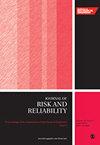Active domain adaptation method for label expansion problem
IF 1.8
4区 工程技术
Q3 ENGINEERING, INDUSTRIAL
Proceedings of the Institution of Mechanical Engineers Part O-Journal of Risk and Reliability
Pub Date : 2022-12-20
DOI:10.1177/1748006x221140487
引用次数: 0
Abstract
Over the past few years, cross-domain fault detection methods based on unsupervised domain adaptation (UDA) have gradually matured. However, existing methods usually assume that the source and target domains have the same label domain space, but ignore the problem of label expansion in the target domain. The source domain of such problems lacks transferable knowledge of newly added health categories, so the domain invariant features extracted by the UDA model only have a large correlation with the source domain health categories, but lack the key features to distinguish the newly added health categories. We found that most of the diagnostic results of this type of samples are distributed at the decision boundary of the source domain health category, and this special distribution means that the newly added health category samples have a high amount of information. Therefore, this paper considers using active learning to select samples of newly added health categories in the target domain to assist model training, and proposes an active domain adaptation intelligent fault detection framework LDE-ADA to deal with the label expansion problem. Finally, on the rotating machinery dataset, the analysis and comparison are carried out through six transfer tasks. The results show that when there is one new health category, the accuracy of LDE-ADA will increase by about 9.39% in the case of labeling three samples per round and training for 20 rounds. Experiments show that this method is an effective method to deal with the label expansion problem.标签扩展问题的主动域自适应方法
近年来,基于无监督域自适应(UDA)的跨域故障检测方法逐渐成熟。然而,现有的方法通常假设源域和目标域具有相同的标签域空间,而忽略了目标域的标签扩展问题。这类问题的源域缺乏新增健康类别的可转移知识,因此UDA模型提取的域不变特征仅与源域健康类别具有较大的相关性,而缺乏区分新增健康类别的关键特征。我们发现,这类样本的诊断结果大部分分布在源域健康类别的决策边界上,这种特殊的分布意味着新增的健康类别样本信息量很大。因此,本文考虑利用主动学习在目标域中选取新增健康类别样本来辅助模型训练,并提出一种主动域自适应智能故障检测框架LDE-ADA来解决标签扩展问题。最后,在旋转机械数据集上,通过6个传递任务进行分析比较。结果表明,在每轮标记3个样本,训练20轮的情况下,当新增一个健康类别时,LDE-ADA的准确率将提高约9.39%。实验表明,该方法是解决标签扩展问题的有效方法。
本文章由计算机程序翻译,如有差异,请以英文原文为准。
求助全文
约1分钟内获得全文
求助全文
来源期刊

Proceedings of the Institution of Mechanical Engineers Part O-Journal of Risk and Reliability
ENGINEERING, MULTIDISCIPLINARY-ENGINEERING, INDUSTRIAL
CiteScore
4.50
自引率
19.00%
发文量
81
审稿时长
6-12 weeks
期刊介绍:
The Journal of Risk and Reliability is for researchers and practitioners who are involved in the field of risk analysis and reliability engineering. The remit of the Journal covers concepts, theories, principles, approaches, methods and models for the proper understanding, assessment, characterisation and management of the risk and reliability of engineering systems. The journal welcomes papers which are based on mathematical and probabilistic analysis, simulation and/or optimisation, as well as works highlighting conceptual and managerial issues. Papers that provide perspectives on current practices and methods, and how to improve these, are also welcome
 求助内容:
求助内容: 应助结果提醒方式:
应助结果提醒方式:


